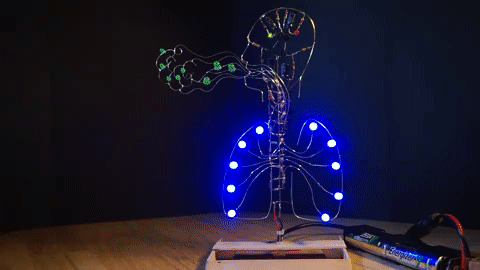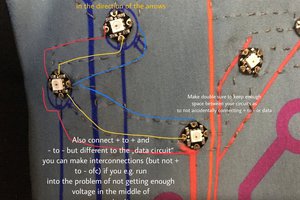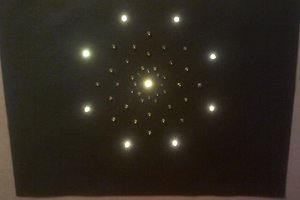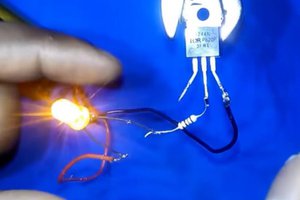The "lightsaber circuit" consists of a capacitor that is charged or discharged via a resistor. An array of LEDs are illuminated in sequence according to the voltage on the capacitor in much the same way as a VU meter or battery level indicator. I use a pair of these in the sculpture - one for the exhaled/inhaled cloud of green LEDs and one for the pair of lungs. For the latter, the blue LEDs are doubled up in parallel for each NPN transistor. A 1 mm thick brass wire acts as both the ground rail and literally as a backbone that supports the entire structure. A 0.8mm thick brass wire in the shape of a human head in silhouette acts as the positive supply rail for the astable multivibrator.

The complete circuit was first assembled on breadboard so that resistor and capacitor values could be adjusted until all LEDs were approximately evenly illuminating, and the extension/contraction timing was consistent with a fairly rapid pace of human breathing - not completely relaxed, but not hyperventilating either.
I didn't use any special rigs to position the components for soldering. Each component was removed directly from the breadboard then positioned and assembled piece by piece in a pretty much organic process. I did sketch out very roughly where the multivibrator parts would be positioned so that I could plan for what size of head to bend using the jewelry wire. Most of the components had been recycled by my dad from old defunct electronics. I did use new resistors when I couldn't find appropriate values. All the transistors are C945 NPNs desoldered from discarded PCBs, as are all the diodes. The green and blue LEDs came from an assortment kit purchased from Ebay.

The green LED constellation is supposed to give the appearance of a cloud being expelled from the mouth of a human. I used a mixture of 5mm LEDs (representing larger droplets) and 3mm LEDs (representing aerosols) as a reference to recent scientific findings on how the virus particles of the current pandemic spreads through the air.
The circuit sculpture is powered from a 5-6V supply - so 4 AA batteries (NiMH or Alkaline) or a USB charger would work. There is no microcontroller to program and no other ICs are used. Not even a 555 timer. To make it more obvious that this is a 100% analog circuit made entirely from discrete components, I created a very minimal base from a few wooden lolly sticks. You can easily see through the structure to confirm that there are no ICs or modules hidden anywhere.
I explore alternative "lightsaber circuits" in an older video which might be of interest:
 bornach
bornach





 moko
moko
 Dr. Cockroach
Dr. Cockroach

 Silícios Lab
Silícios Lab
This is really cool! Could you explain how this works for someone (like me) who doesn't know much about analog electronics? Thanks